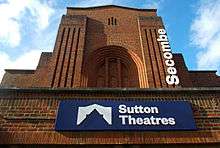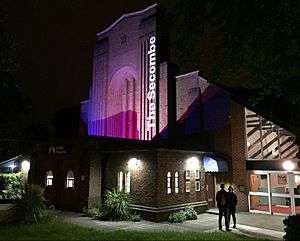Secombe Theatre
|
As seen from Cheam Road 2016 | |
| Address |
42 Cheam Rd, Sutton SM1 2SS Greater London England |
|---|---|
| Coordinates | 51°21′42″N 0°11′50″W / 51.361707°N 0.197146°W |
| Owner | Sutton London Borough Council |
| Operator | Sutton Theatres Trust |
| Capacity | 343–396 |
| Opened | 1984 |
| Website | |
| http://www.suttontheatres.co.uk/ | |
The Secombe Theatre, named after Sir Harry Secombe, is in Cheam Road, Sutton, Greater London.[1] The theatre was opened by Sir Harry, who lived in Sutton for over 30 years.[2] The theatre went into administration and shut in August 2016.
Theatre building
The theatre was created in 1984 out of a red-brick former Christian Science church on a large plot on Cheam Road at its junction with Gibson Road.[1] The plot once formed part of an estate, and the original church building dates from 1937. The Theatre Trust describes the current building as commanding "a presence in the landscape".[1]
The auditorium can accommodate 396 patrons, or 343 when the orchestra pit is being used, and it is tiered facing the end-on stage. The stage is a flat floor proscenium arch, and there is adequate wing space. Backstage there are four dressing rooms (with capacities ranging from ten to twenty cast members each). Under the previous managements, there was a multi-purpose room at the back of the theatre. Since taking over the theatres in June 2015, the new Sutton Theatres Trust has created a new 120-seat venue (180 standing capacity) in the room complete with its own sound and lighting rig as well as a self-contained bar. It was renamed "Back Door @ The Secombe". Daytime it provides an affordable rehearsal space.[3][4] A large glass extension to the east side of the original building provides a bar and refreshment area, which is also open to the general public.[1]
Productions and events

Productions at the Secombe can include both modern productions and old, established plays given a new twist.[5] Since June 2015, it has become both a producing house and a receiving house.[6] It produces two to three in-house productions a year, include a pantomime. Under the new management, the theatre also co-produces with theatres nationally and internationally. It now attracts big headline comedians and continues to provide space for local community groups.[7][8][9][10] Run as a multi-purpose entertainment venue, the theatre also hosts conference events.[1]
Past productions have included Steel Magnolias, The Tempest, Journey's End, and Accidental Death of an Anarchist.[11] In a 2009 review of Souwest 09, the Croydon Advertiser awarded the performance four stars, and described it as "visually vibrant".[12]
A forthcoming production – the world première of the new Edward Bond play, Dea – was included in a BBC News article on the highlights of what UK theatres will be staging during 2016.[13][14][15][16] Bond is said to have an "uneasy relationship with the theatre establishment", feeling that engaging people's intellect is no longer a priority for it. It was this that led to his decision to choose Sutton over the West End for the staging of the play. He said: “I would like to create something here which you couldn’t do in the West End, you couldn’t do at the Royal Court, you couldn’t do at the RSC – and I know because I worked at these places. They are all part of the entertainment industry.”[17][18][19] In a review entitled "Is Dea The Most Extreme Play London Has Ever Seen", the Londonist said: "The play is a deep, poetic, complex investigation of the condition of 21st century society....Dea is absolutely the best reason to come to Sutton. For anyone who wishes for more difficult, adventurous, new writing outside subsidised theatres, this is it."[20]
Former operation of the theatre
The Secombe Theatre is operated together with the nearby Charles Cryer Studio Theatre, named after the campaigner for the Secombe Theatre. (The Charles Cryer Theatre is in a former hall in Carshalton, which was converted to theatre in 1991.) Financial difficulties in 2002 had put the theatre in jeopardy, but its future was believed secure the following year when it was taken over by the London Borough of Sutton and run directly by the council. [21]
2014 to 2015 closure risk, rescue and renaissance
In 2014, because of local council budget cuts, the venue was, along with its sister theatre, the Charles Cryer Theatre in Carshalton, identified by the Theatre Trust as one of 33 theatres in the country for inclusion on its "At Risk" register.[22] The risk of closure spurred celebrity intervention in favour of the two theatres: writer, actor, comedian and BBC presenter Tim Vine, called on Sutton Council to reconsider its proposals.[23]
On 10 November 2014 the local council announced that four organisations submitting outline bids to take over the two theatres had been invited to submit full business cases by 12 December. The council worked with the Theatres Trust and Sutton Centre for Voluntary Services to help bidders through the bidding process.[24] On 15 January 2015 the bid by the new "Sutton Theatres Trust" (STT) was given approval by the council's environment and neighbourhood committee to take over the theatres, thus saving them from closure. Speaking about the future running of the theatres, a spokesperson for STT said:[25]
"...They really want to keep the theatres alive, have them work hard, supporting the community. The vision is to focus on community projects as well as classical and contemporary theatre, and big scale commercial dance and comedy events..."
In June 2015 the theatres were official handed over to the STT. Cllr Jill Whitehead said:[26]
"Now we can look forward to an exciting programme of activity to be unveiled by Sutton Theatres Trust this summer and their contribution to cultural life in Sutton.”
August 2016 closure
In August 2016, the Sutton Theatre Trust went into administration and the theatre (along with its sister theatre in the borough) closed. The administrator is now looking for a buyer for the Trust. Audience numbers had doubled under the new management, but this was still not enough for the Trust to be financially viable without additional support.[27]
Transport
Sutton mainline railway station is the nearest station. The Gibson Road car park is adjacent, and buses serve the town.[28]
References
- 1 2 3 4 5 "Secombe Theatre". Theatres Trust. Retrieved 4 October 2014.
- ↑ "Sir Harry Secombe". Explore Gower. Retrieved 14 October 2014.
- ↑ The Stage
- ↑ Sutton Theatres About Us
- ↑ "Secombe Theatre". UK Attraction. Retrieved 4 October 2014.
- ↑ House theatre website
- ↑ Sutton Guardian article
- ↑ Sutton Theatres
- ↑ Sutton Theatres Our Vision
- ↑ Broadway World
- ↑ "What's on Stage website regarding Secombe Theatre". Retrieved 13 October 2014.
- ↑ Peter Steptoe (13 November 2009). "Theatre Review: Souwest 09, Secombe Theatre, Sutton". Croydon Advertiser. Retrieved 13 October 2014.
- ↑ BBC News
- ↑ Sutton Theatres
- ↑ 13 January 2016, Sutton Guardian
- ↑ 22 April 2016, Sutton Guardian
- ↑ Sutton Guardian 8 February 2016
- ↑ The Stage, 9 February 2016
- ↑ The Guardian Newspaper, 22 May 2016
- ↑ The Londonist, 7 June 2016
- ↑ "Over the footlights website, regarding the Secombe Centre Theatre" (PDF). Retrieved 4 October 2014.
- ↑ Ian Youngs (18 September 2014). "Theatres Trust lists 33 historic theatres 'at risk'". BBC. Retrieved 4 October 2014.
- ↑ "Comic legend Tim Vine takes to Twitter to call on Sutton Council to halt theatre closure plans". Sutton Guardian. 17 September 2014. Retrieved 4 October 2014.
- ↑ "Four bids to take over Sutton's theatres invited to submit full business case". London Borough of Sutton Press Office. Retrieved 18 December 2014.
- ↑ "Dramatic rescue for Sutton's theatres as new 10-year takeover deal gets nod". Sutton Guardian. 21 January 2015. Retrieved 22 January 2015.
- ↑ Sutton Guardian
- ↑ The Stage, 12 August 2016
- ↑ Sutton Theatres How to find us
External links
![]() Media related to Theatres in the London Borough of Sutton at Wikimedia Commons
Media related to Theatres in the London Borough of Sutton at Wikimedia Commons
